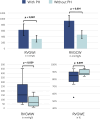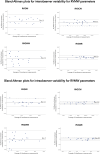Right ventricular myocardial work: proof-of-concept for the assessment of pressure-strain loops of patients with pre-capillary pulmonary hypertension
- PMID: 39748402
- PMCID: PMC11697866
- DOI: 10.1186/s12947-024-00335-x
Right ventricular myocardial work: proof-of-concept for the assessment of pressure-strain loops of patients with pre-capillary pulmonary hypertension
Abstract
Background: Right ventricular myocardial work (RVMW) assessed by transthoracic echocardiography allows to study the right ventricular (RV) function using RV pressure-strain loops. The assessment of these novel indexes of RVMW has not yet been exten sively studied, namely in pre-capillary pulmonary hypertension (PH) population.
Objectives: to evaluate the relationship between RVMW and invasive indices of right heart catheterization (RHC) in a cohort of patients with group I and group IV PH and to compare with a control group without PH.
Methods: A prospective registry of pre-capillary PH patients was used and compared with a control group without PH. In both groups, patients underwent same day RHC and echocardiographic assessment. Dedicated software for left ventricle myocardial work was used for the RV. RV global work index (RVGWI) was calculated as the area of the RV pressure-strain loops. From RVGWI, RV global constructive work (RVGCW), RV global wasted work (RVGWW), and RV global work efficiency (RVGWE) were estimated.
Results: 25 pts were included: 17 pts with PH were compared with 8 pts without PH. RVGWI, RVGCW and RVGWW were significantly higher in PH patients than in controls (p < 0,05), while RVGWE was significantly lower (p < 0,05). Significant correlations were found between mean pulmonary artery pressure, cardiac index, venous oxygen saturation, NT-proBNP and RVGCW, RVGWW and RVGWE; between pulmonary vascular resistance, cardiac output, right ventricular stroke work and RVGWI, RVGCW, RVGWW and RVGWE; between stroke volume and RVGWW and RVGWE; between pulmonary artery pulsatility index and RVGWI, RVGCW and RVGWW; between RA pressure and RVGWE.
Conclusions: Patients with pre-capillary PH present significantly higher RVGWI, RVGCW and RVGWW and lower RVGWE than patients without PH. Echocardiographic RVMW-derived indexes show significant correlation with invasive measurements and NT-proBNP. Larger studies are needed to assess the prognostic value of these novel indexes.
Keywords: Echocardiography; Myocardial work; Pulmonary hypertension; Right heart catheterization; Right ventricle function; Strain analysis.
© 2024. The Author(s).
Conflict of interest statement
Declarations. Competing interests: The authors declare no competing interests. This research received no specific grant from any funding agency in the public, commercial, or not-for-profit sectors. This research received no specific grant from any funding agency in the public, commercial, or not-for-profit sectors. The hospital ethics committee (ULS São José) approved the study protocol. All participants provided written informed consent and all procedures carried out in this study were conducted according to the Declaration of Helsinki guidelines. The data base used and analysed during the current study is available from the corresponding author on reasonable request. All authors read and approved the final manuscript.
Figures
Similar articles
-
Right Ventricular Myocardial Work Characterization in Patients With Pulmonary Hypertension and Relation to Invasive Hemodynamic Parameters and Outcomes.Am J Cardiol. 2022 Aug 15;177:151-161. doi: 10.1016/j.amjcard.2022.04.058. Epub 2022 Jun 9. Am J Cardiol. 2022. PMID: 35691706
-
Right ventricular myocardial work: proof-of-concept for non-invasive assessment of right ventricular function.Eur Heart J Cardiovasc Imaging. 2021 Jan 22;22(2):142-152. doi: 10.1093/ehjci/jeaa261. Eur Heart J Cardiovasc Imaging. 2021. PMID: 33184656
-
Noninvasive right ventricular work in patients with atrial septal defects: a proof-of-concept study.Cardiovasc Ultrasound. 2023 May 20;21(1):10. doi: 10.1186/s12947-023-00306-8. Cardiovasc Ultrasound. 2023. PMID: 37210542 Free PMC article.
-
Assessment of right ventricular systolic function by tissue Doppler echocardiography.Dan Med J. 2012 Mar;59(3):B4409. Dan Med J. 2012. PMID: 22381093 Review.
-
Multimodality Imaging to Understand Mechanisms of Right Ventricular Disease.Can J Cardiol. 2025 Jun;41(6):1126-1141. doi: 10.1016/j.cjca.2025.03.033. Epub 2025 Apr 4. Can J Cardiol. 2025. PMID: 40188873 Review.
References
-
- Humbert M, Kovacs G, Hoeper MM, et al. 2022 ESC/ERS guidelines for the diagnosis and treatment of pulmonary hypertension: developed by the task force for the diagnosis and treatment of pulmonary hypertension of the European Society of Cardiology (ESC) and the European Respiratory Society (ERS). Endorsed by the International Society for Heart and Lung Transplantation (ISHLT) and the European Reference Network on rare respiratory diseases (ERN-LUNG). Eur Heart J. 2022;43(38):3618–731. - PubMed
-
- Tadic M, Pieske-Kraigher E, Cuspidi C, et al. Right ventricular strain in heart failure: clinical perspective. Arch Cardiovasc Dis. 2017;110(10):562–71. - PubMed
-
- Sachdev A, Villarraga HR, Frantz RP, et al. Right ventricular strain for prediction of survival in patients with pulmonary arterial hypertension. Chest. 2011;139(6):1299–309. - PubMed
-
- Potter E, Marwick TH. Assessment of Left ventricular function by Echocardiography: the case for routinely adding global longitudinal strain to ejection Fraction. JACC Cardiovasc Imaging. 2018;11(2 Pt 1):260–74. - PubMed
-
- Klaeboe LG, Edvardsen T. Echocardiographic assessment of left ventricular systolic function. J Echocardiogr. 2019;17(1):10–6. - PubMed
MeSH terms
LinkOut - more resources
Full Text Sources
Medical
Research Materials



